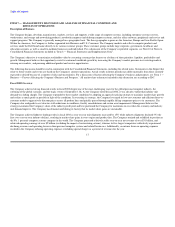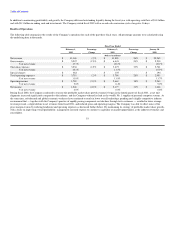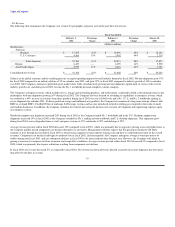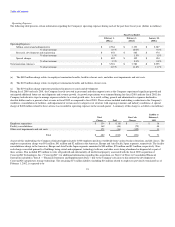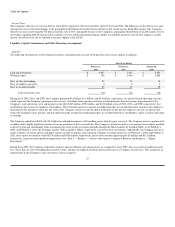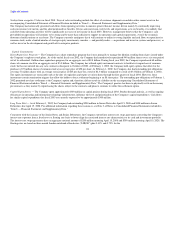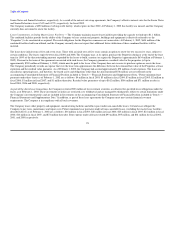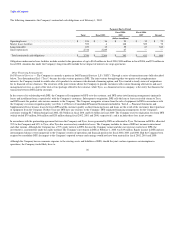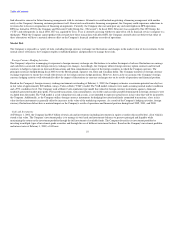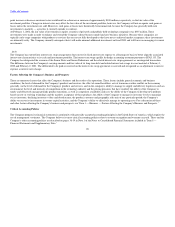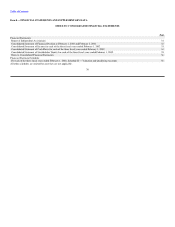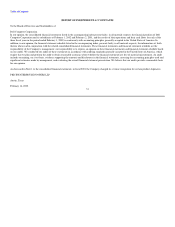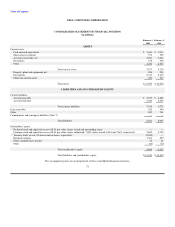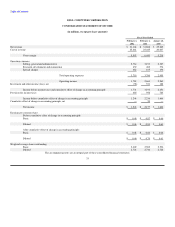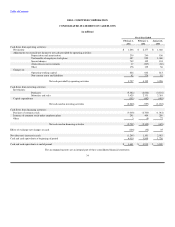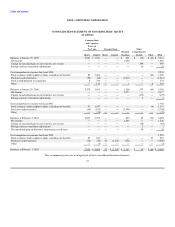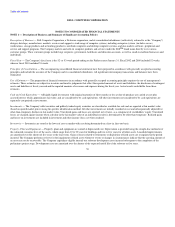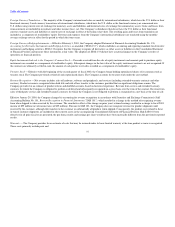Dell 2001 Annual Report Download - page 30
Download and view the complete annual report
Please find page 30 of the 2001 Dell annual report below. You can navigate through the pages in the report by either clicking on the pages listed below, or by using the keyword search tool below to find specific information within the annual report.
Table of Contents
find alternative sources for future financing arrangements with its customers. Alternatives could include negotiating a financing arrangement with another
entity or the Company's financing customer purchases itself. Absent such an alternative financing arrangement, the Company could experience reductions in
revenues due to losses in originations of financing arrangements. Currently, the Company does not anticipate any such interruption in DFS operations.
DFS was formed in 1998 by the Company and Newcourt Credit Group, Inc. ("Newcourt"). In fiscal 2000, Newcourt was acquired by The CIT Group, Inc.
("CIT") and subsequently, in fiscal 2002, CIT was acquired by Tyco. Tyco is currently assessing whether to spin-off or sell its financial services company to a
third party. While the Company cannot predict with certainty how these transactions will affect DFS, the Company currently does not believe that either of
these alternatives will have a material adverse effect on the Company's financial condition or results of operations.
Market Risk
The Company is exposed to a variety of risks, including foreign currency exchange rate fluctuations and changes in the market value of its investments. In the
normal course of business, the Company employs established policies and procedures to manage these risks.
Foreign Currency Hedging Activities
The Company's objective in managing its exposure to foreign currency exchange rate fluctuations is to reduce the impact of adverse fluctuations on earnings
and cash flows associated with foreign currency exchange rate changes. Accordingly, the Company utilizes foreign currency option contracts and forward
contracts to hedge its exposure on forecasted transactions and firm commitments in most of the foreign countries in which the Company operates. The
principal currencies hedged during fiscal 2002 were the British pound, Japanese yen, Euro and Canadian dollar. The Company monitors its foreign currency
exchange exposures to ensure the overall effectiveness of its foreign currency hedge positions. However, there can be no assurance the Company's foreign
currency hedging activities will substantially offset the impact of fluctuations in currency exchange rates on its results of operations and financial position.
Based on the Company's foreign currency exchange instruments outstanding at February 1, 2002, the Company estimates a maximum potential one-day loss
in fair value of approximately $20 million, using a Value-at-Risk ("VAR") model. The VAR model estimates were made assuming normal market conditions
and a 95% confidence level. The Company used a Monte Carlo simulation type model that valued its foreign currency instruments against a thousand
randomly generated market price paths. Forecasted transactions, firm commitments, receivables and accounts payable denominated in foreign currencies were
excluded from the model. The VAR model is a risk estimation tool, and as such, is not intended to represent actual losses in fair value that will be incurred by
the Company. Additionally, as the Company utilizes foreign currency instruments for hedging forecasted and firmly committed transactions, a loss in fair
value for those instruments is generally offset by increases in the value of the underlying exposure. As a result of the Company's hedging activities, foreign
currency fluctuations did not have a material impact on the Company's results of operations and financial position during fiscal 2002, 2001, and 2000.
Cash and Investments
At February 1, 2002, the Company had $8.3 billion of total cash and investments (including investments in equity securities discussed below), all of which is
stated at fair value. The Company's investment policy is to manage its total cash and investments balances to preserve principal and liquidity while
maximizing the return on the investment portfolio through the full investment of available funds. The Company diversifies its investment portfolio by
investing in multiple types of investment-grade securities and through the use of different investment brokers. Based on the Company's investment portfolio
and interest rates at February 1, 2002, a 100 basis
27


